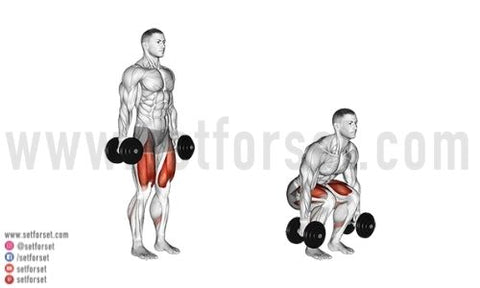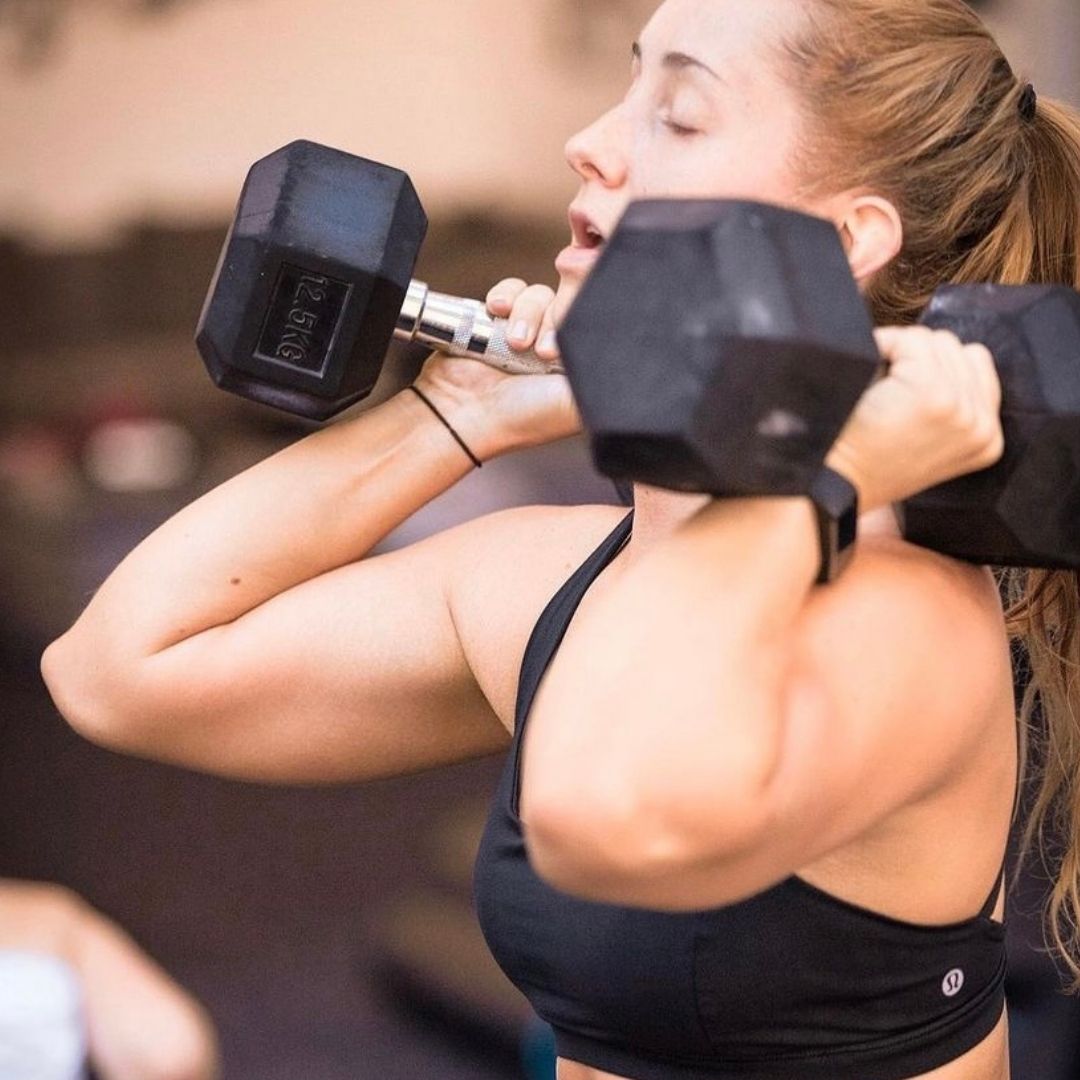Looking to improve your squat strength and versatility? Swapping the barbell for dumbbells might be your best move. Dumbbell squats allow for varied grips, easier loading, and more movement options—all while building serious strength and muscle.
This guide covers:
Take Your Fitness To The Next Level
-
Proper dumbbell squat form
-
7 best dumbbell squat variations
-
Benefits and muscles worked
-
Common mistakes
-
How to program and progress your squats

How To Perform Dumbbell Squats
General Form For Dumbbell Squats:

Regardless of grip style, squat mechanics remain the same:
-
Stand with feet hip-width apart, core braced, and chest high.
-
Lower your hips back and down until thighs are parallel.
-
Press through your heels to return to standing, squeezing glutes at the top.
Grip Positions:
-
Arms at sides
-
Goblet (dumbbell held at chest)
-
Front rack (dumbbells at shoulders)
-
Overhead (advanced)
7 Best Dumbbell Squats
These squat variations utilize different grip and stance positions. Including a few variations in your routine allows for more well-rounded development in strength, hypertrophy, and athleticism.
The 7 best dumbbell squats are:
- Goblet Squat
- Arms To Side Squat
- Racked Dumbbell Squat
- Overhead Squat
- Dumbbell Sumo Squat
- Dumbbell Split Squat
- Dumbbell Side Squat
Let's take a closer look at each squat variation.
1) GOBLET HOLD:

A great foundational movement, the goblet squat involves holding a single dumbbell vertically at your chest. This position shifts the center of gravity forward, promoting upright posture and engaging the core.
It’s ideal for beginners learning squat mechanics but also effective for seasoned lifters as an accessory move. The goblet hold challenges your arms, shoulders, and core while emphasizing quad and glute development.
If you prefer to use two dumbbells to increase the load, you can choose the following holding positions...
2) ARMS TO SIDES SQUAT (easiest grip option):

With dumbbells hanging at your sides, this variation closely mimics the feel of a trap bar deadlift. It’s easier to maintain balance and form, making it a solid option for heavier loads. You can focus more on lower body engagement without stressing the upper body. Just ensure your posture stays upright and the weights stay controlled during the descent and ascent.
3) RACKED DUMBBELL SQUATs (Hardest Grip Position):

Holding dumbbells at shoulder level, this variation demands more from your upper back, shoulders, and core. The front-loaded position encourages a more vertical torso and increases anterior chain activation. It’s great for developing quad strength and mimics the barbell front squat but is more joint-friendly and accessible for most lifters.
Note: The goblet and racked position will require more upper body work than the arms extended down to the side hold (such as your core, back, and arms) to keep the dumbbells in place and your torso upright.
4) OVERHEAD SQUAT:

This is more of a specialty squat hold variation, but nevertheless, a great way to build total body, real world strength as well as improve mobility. This will be by far the hardest variation to load heavily and most will do best to use a light to moderate load.
5) DUMBBELL SUMO SQUATS:

While sumo squats work your legs and glutes just like regular squats, the exercise emphasizes your side glutes/hip abductors (gluteus medius & minimus) as well as your inner thighs.
With sumo squats, you have different holding positions, such as with arms extended down between your legs (can be done with one or two dumbbells), goblet, or front racked as well (or even overhead).
6) DUMBBELL SPLIT SQUATS:

Dumbbell split squats also work your legs, glutes and calves, but they place greater emphasis on your glutes and quads (particularly the area of the quadriceps around the knee) as well as core strength & stability.
They will even work your calves to a higher degree simply for balance purposes. When comparing split squats vs lunges, split squats are a great first step as they provide a bit more balance.
You can have both feet flat on the ground or raise the front one up to increase the difficulty via increased range of motion.
Holding position options are the same as the standard dumbbell squat.
7) DUMBBELL SIDE SQUATS:

Like sumo squats, side squats place focus on your hip abductors and hip adductors. Side squats also increase the activation of the hamstrings more than a regular squat.
You won't be able to go nearly as heavy with the side squat as you can a sumo squat though, but the exercise is considerably more difficult due to the range of motion and hip mobility needed. Start light with this one (or even just your own bodyweight).
Goblet or front racked with be the best dumbbell holding positions for side squats.
Other good dumbbell squat variations include:
- Plie Squats
- Heels Elevated Squat
- Bulgarian Split Squat
- Box Squats
- Single Leg Box Squats
- Pistol Squats
- Jump Squats
- Squat Thrusters
- Clean Squats
- Swing Squats
Note: The ones in our list are the best to start with and are more than enough in terms of variability for strength and building muscle. And, if you need to master form before adding weights, start with bodyweight squats.
3 Common Dumbbell Squat Mistakes
1. Rounding Back or Shoulders
Keep core tight and spine neutral. Use a mirror for feedback.
2. Knee Valgus (Knees Caving In)
Strengthen hips and improve mobility. Focus on tracking knees over toes.
3. Rising Onto Toes
Keep feet planted and drive through heels. Heel elevation or mobility work may help.

Benefits of Dumbbell Squats
The 4 benefits of dumbbell squats are:
- Versatility
- Progress More Quickly
- Compound Lift = More Muscles Worked & Calories Burned
- Improves Grip Strength
1. VERSATILITY & VARIATIONS:
Dumbbells provide incredible freedom of movement. Not only can you alter the difficulty by simply choosing an easier or harder holding position, but you have several more variables to play around with such as body positioning and unilateral training.
You can easily shift your foot placement and weight load placement, as well as train with one dumbbell or two.
With the versatility and variety that you can have with dumbbells, they also stimulate metabolic and mechanic overload, which can boost the size of muscles.
2. PROGRESSION & STRENGTH GAINS:
A dumbbell's starting weight will be much less than a barbell, so if you only want to add 5-10 pounds to your squat to start, then work up from there, dumbbells allow that. This means you can make gains more quickly as it's easier to bump up the weight a bit.
Of course, barbells have a higher ceiling in terms of weight load, but dumbbells provide greater versatility in terms of load. For most people, dumbbells are more than enough to get to the strength level they want and to build the legs they want.¹
If you want to start squatting really heavy, at some point you'll need to upgrade to a barbell. HOWEVER, that doesn't mean you'll be done with dumbbells forever. Dumbbells can always have their place for squats, such as if you wanted to do a superset, accessory work, a circuit workout, or HIIT-style workout.
3. COMPOUND MOVEMENT & MORE MUSCLES WORKED:
Dumbbell squats target the lower body, specifically the glutes, quads, and hamstrings. But the core is also working overtime in a dumbbell squat just to keep those dumbbells in place and to maintain good form.
Activation of these lower body and upper body muscles translates to improved performance with activities of daily living, and can increase sports performance as well.
4. GRIP STRENGTH:
As you start to use heavier dumbbells, this becomes more apparent. Just holding onto dumbbells while squatting will help you to build incredible grip strength, which is a crucial component of fitness.
If you don't know the importance of grip strength and why you should take it serious, then you need to read this article we wrote on grip strength.
Muscles Worked in a Dumbbell Squat
The three major lower body muscles worked in a squat include:
- Glutes
- Quads
- Hamstrings
In addition, dumbbell squats strengthen the calves, lower back, and core. Muscles within the upper back and arms are also working, while you are maintaining a solid grip on your dumbbells!
Want to target all your leg muscles with dumbbells? Check out our post Dumbbell Leg Workout that will be sure to get those legs firing on all cylinders.
Training Variables (Volume & Frequency):
The way that you choose to incorporate dumbbell squats into a routine will be based on goals, current fitness level, and current and past injury history, just to name a few factors to consider. However, there are some things to keep in mind regarding training variables.
- Reps and sets: The dumbbell squat is a compound movement, so starting with lower weight and lower reps isn’t a bad thing – especially if you need to ensure that your form and technique stay on point. Once you’ve got the movement down, then reps of 12-15 for 2-3 sets with a lighter weight is where you’ll want to be to develop endurance within the lower body. If your goal is more along the lines of strength and mass, then 8-10 reps for a span of 4-5 sets with a heavier dumbbell is more ideal.
- Rest: Taking time for recovery is imperative, especially if you are recovering from an injury or are brand new to working out. You don’t need to do dumbbell squats every day – after all, those muscles need time to repair and rebuild! Work this movement into a routine where you can get at least 24 hours of down time in between workouts; no need to go overboard on back-to-back squat days.
How To Progressive Overload with Dumbbell Squats
It's actually quite easy to progressive overload with dumbbells. Before moving on to more challenging movements, ensure that your form and technique are correct!
1) Increase Weights:
One of the first ways that you can make the dumbbell squat more challenging is to increase the weight of your dumbbells. This should be done incrementally, and not in huge steps. Your core and overall stabilization will need to learn and adjust to new weight, and your legs will certainly feel it!
2) Focus On Eccentric Contraction:
Another progression you can make with dumbbell squats is to work on the negative, or the eccentric phase of the movement.
This essentially means that instead of taking a count or two to drop down into your squat, you’re extending that out to three, four, or even five counts. If done correctly, this added time under tension will have you working much harder than you were before!
3) Incorporate Squats Into Supersets:
If you are wanting to add other movements into your routine (and you definitely should), then working the dumbbell sets into a solid program is another way to progress – especially if you work them into a routine similar to a superset.
For example, do a set of dumbbell squats, immediately move into a set of lunges, and then you’ll be right back to the next set of squats for a given rep scheme and/or time.
Dumbbell Squats: Final Takeaways
The DB squat is a highly versatile compound movement that can improve your functionality throughout activities of daily living – all while providing an excellent base of strength and stability to your lower body and core.
Incorporate dumbbell squats into your program and you are sure to reap the benefits.
Interested in learning 15 more great squat variations? Check out our Squats Guide!

References:
- Krzysztofik M, Wilk M, Wojdała G, Gołaś A. Maximizing Muscle Hypertrophy: A Systematic Review of Advanced Resistance Training Techniques and Methods. International journal of environmental research and public health. 2019. doi:https://doi.org/10.3390/ijerph16244897





1 comment
They deliver !